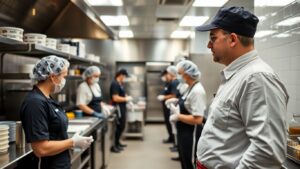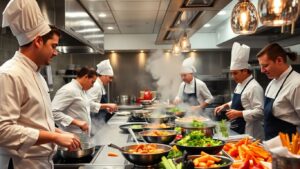

If you’re thinking about becoming a restaurant supervisor or you’re hiring for the role, it’s good to know what’s actually involved in the job. Restaurant supervisor job responsibilities cover way more than just telling people what to do. You’re in charge of keeping the place running, making sure customers leave happy, and that the team works well together. It’s a hands-on job with lots of moving parts, from staff management to food quality and even paperwork. Let’s break down what you can expect if you step into this role, or what you should look for if you’re hiring.
Restaurant supervisors have a lot on their plate, but it all boils down to making sure the place runs without a hitch. From opening up in the morning to locking up at the end of the night, it’s their job to watch over both the bigger picture and the tiny details. Here’s what these core tasks look like day to day:
Keeping the day moving smoothly is what sets a good supervisor apart. It’s about balancing a hundred things at once and being the person everyone turns to for answers.
Consistency is key here—not just in taste, but in speed and appearance, too. Customers should always know what to expect.

There’s never an excuse for overlooking health and safety. Even the best-run restaurant can get into trouble if standards slip, so regular checks and training are a must.
| Task | Completed? |
|---|---|
| Open/close restaurant | [ ] |
| Restock inventory | [ ] |
| Check equipment | [ ] |
| Review food quality | [ ] |
| Health/safety spot inspection | [ ] |
| Staff check-in | [ ] |
Restaurant supervisors juggle these responsibilities each shift, making them a steady hand in a job that never slows down.
Restaurant supervisors must not just oversee operations; they are also the backbone of staff growth and teamwork. It’s all about creating a consistent work environment where staff feel supported, schedules are clear, and new hires don’t feel lost on day one. Here’s what this really looks like in day-to-day practice:
A big part of this job is keeping shifts covered and making sure no one is overworked or underutilized. Most supervisors will:
| Task | Frequency | Impact |
|---|---|---|
| Make shift schedules | Weekly | Smooth coverage |
| Handle shift changes | As needed | Less stress |
| Track attendance issues | Daily/Weekly | Fewer surprises |
When new people join the team, it’s the supervisor who sets the tone and pace for their success. Some standard practices include:
Consistent and clear onboarding cuts down on mistakes, boosts retention, and helps everyone feel more prepared for a busy shift.
Getting the best out of every team member takes more than pointing out what went wrong. Supervisors need to motivate and develop their staff. Common ways to do this are:
Teams are more likely to work hard and stick together when they know their supervisor actually sees their effort and values honest communication.
If you’re serious about being a strong restaurant supervisor, focusing on staff leadership and development is where you make the biggest difference. It’s not just about managing people; it’s about building capacity and trust.
The customer experience is shaped not just by the food but by every single interaction guests have with the restaurant team. Restaurant supervisors hold a big part in shaping how guests feel during and after their visit. Here’s what’s involved in improving service and solving guest concerns.
Handling issues quickly—and with real attention—makes guests more likely to come back, even after a mix-up.
A restaurant supervisor should regularly:
A table of simple customer feedback examples might look like this:
| Feedback Type | How to Respond |
|---|---|
| Cold food | Offer a fresh replacement |
| Slow service | Apologize, state reason, compensate if needed |
| Unfriendly staff | Thank guest, address privately with staff |
Consistent and honest communication with guests goes a long way in making small problems feel minor, not major.
Good guest experiences don’t happen by accident. Here are practical steps to train your team, as seen in restaurant guest service strategies:
And always remember: the way staff treats guests is a reflection of the supervisor’s standards.
Careful management of inventory and costs keeps the kitchen running day in and day out. It’s not just about ordering food. There’s a real method to making sure supplies don’t run out—or spoil in the fridge. Let’s break it down.
Supervisors need to place orders for ingredients and supplies with a steady hand. This means tracking what’s used every week, making deals with vendors, and timing deliveries so nothing runs out right before a rush.
Things to keep in mind:
Constant tracking is required so staff know exactly what’s on hand. There’s nothing worse than thinking you have enough chicken, only to run out during dinner service. Keeping an eye on every ingredient helps spot theft, spoilage, and simple miscounts.
Below is a sample of how inventory data might be tracked each week:
| Item | Last Week (kg) | Used (kg) | Current Stock (kg) | Notes |
|---|---|---|---|---|
| Chicken Breast | 20 | 16 | 4 | Order soon |
| Rice | 50 | 10 | 40 | Sufficient |
| Lettuce | 12 | 9 | 3 | High usage |
Stock reviews often uncover patterns, like an item suddenly disappearing faster than expected, pointing to a problem worth fixing.
Budgeting isn’t fun, but it matters. Supervisors monitor menu pricing, staff hours, and ingredient use. Even a few dollars wasted each shift really add up over a month. They look for ways to trim costs—maybe by adjusting staff schedules or tweaking portion sizes—to keep things profitable.
Typical steps for controlling these costs:
Managers who pay attention to the fine print of inventory and costs give the team a smoother workday and set the stage for better profits. It only takes a few regular habits to see what’s going on behind the scenes.
Supervisors in restaurants don’t just manage people and food—they also keep track of important paperwork and keep the business side ticking along smoothly. Let’s break down what this really looks like day-to-day.
Restaurant supervisors are responsible for keeping detailed records that help guide the restaurant’s decisions. This includes tracking sales data, staff hours, and customer counts. Good record-keeping helps keep things transparent if there’s ever a problem and makes future planning easier.
Some of the key records maintained include:
A simple table like this might help organize the essentials:
| Report Type | Frequency | Who Prepares? |
|---|---|---|
| Sales Summary | Daily | Supervisor |
| Inventory Report | Weekly | Supervisor/Manager |
| Maintenance Log | As needed | Supervisor |
| Employee Attendance | Every shift | Supervisor |
At the end of every shift, restaurant supervisors help make sure the numbers add up—literally. They’ll count cash, reconcile POS (Point-of-Sale) tallies, and double-check that there’s no weirdness or errors in the books. Catching mistakes early is a big deal, so this process matters more than most people think.
Supervisors also double-check deposits and sometimes help compile finance reports, working hand-in-hand with senior management or an accountant.
Scheduling isn’t just about plugging names into a calendar. A supervisor needs to balance staff availability, labor laws, and business needs to keep the place running smoothly without overspending.
Some main tasks involve:
When the paperwork piles up or mistakes slip by, it can snowball—nobody wants to deal with upset employees or surprise shortages at the end of the week.
Most supervisors lean on scheduling software, spreadsheets, or old-fashioned charts to keep things sorted. But at the end of the day, attention to detail is what keeps the money side healthy and the team happy.

Restaurant supervisors keep everyone safe in the workplace by making sure rules and procedures are followed every day. They have to watch over the physical space, keep records straight, and help the team understand what the law requires when handling and serving food.
Frequent workplace inspections help catch issues before they get worse. Being consistent with these checks means fewer surprise health or safety problems.
| Area | Frequency | Responsible |
|---|---|---|
| Kitchen floors | At least 2x per shift | Supervisor |
| Storage rooms | Daily | Supervisor |
| Restrooms | Every 2 hours | Assigned staff |
If you’re supervising, you should never assume someone else will catch a missed safety task—double-checking can prevent sick days, accidents, or bad audits.
Supervisors have to remind everyone that meeting legal standards isn’t just about avoiding fines—it’s about protecting guests and staff every time the restaurant opens. These efforts behind the scenes often go unnoticed but make a real difference.
Restaurant supervisors can’t just wing it—they need the right skills on hand, or things go off the rails fast. Successful supervisors blend people skills and real-world know-how to keep everything running smoothly and everyone on track. It’s not just about telling people what to do. It’s about juggling many tasks, solving problems on the spot, and keeping a cool head under pressure.
| Requirement | Typical Expectation |
|---|---|
| Minimum Education | Secondary school diploma |
| Preferred Education | Diploma in hospitality or food service |
| Hands-on Experience | 1-3 years food service experience |
| Safety Certification | FoodSafe Level 1 or equivalent |
The very best supervisors don’t just keep things running—they make sure everyone feels part of the team, and that every guest leaves happy. Without these skills, being in charge at a busy restaurant feels less like teamwork and more like barely controlled chaos.
So, wrapping things up, being a restaurant supervisor with an LMIA approval isn’t just about ticking boxes on a job description. It’s about juggling a bunch of tasks, from making sure the team is on track to keeping customers happy and the kitchen running smoothly. The right person for this job needs to be organized, good with people, and ready to handle whatever comes their way—sometimes all at once. If you’re hiring, don’t just look at experience or certifications. Pay attention to how someone fits with your team and your restaurant’s vibe. And if you’re thinking about applying for this kind of role, know that it’s a job where you’ll learn a lot, move fast, and probably never have a dull day. At the end of the day, a strong supervisor can make a big difference in how a restaurant runs and how everyone feels about coming to work.
A restaurant supervisor makes sure everything runs smoothly in the restaurant. They watch over daily tasks, help with food preparation, check that the service is good, and make sure everyone follows health and safety rules.
A good restaurant supervisor needs to be a strong leader, have good communication skills, and be able to solve problems quickly. They should also be organized and have experience working in restaurants.
Most restaurant supervisors need to finish high school, and many have extra training in food service or restaurant management. Some jobs may also ask for food safety certificates, like FoodSafe Level 1.
Supervisors talk to guests, answer questions, and solve any problems customers have. They also train staff to give great service and make sure customers leave happy.
An LMIA, or Labour Market Impact Assessment, is a paper that lets Canadian employers hire foreign workers when no local workers are available. It’s important because it shows the need for hiring someone from outside Canada for the job.
Supervisors order food and other items, keep track of what’s in stock, and try to reduce waste. They also help control food and labor costs to make sure the restaurant doesn’t spend too much money.

Thinking about a career as a Food Service Supervisor in Canada? It's a pretty solid move right now. The food scene here is booming, and there's a real need for people who can keep things...

Thinking about finding cook jobs in Calgary for 2025? The city's food scene is always buzzing, and places like SALTLIK are looking for talented folks to join their kitchens. Whether you're a seasoned pro or...

Thinking about a career change or looking for your next gig? Canada's food scene is always buzzing, and that means there are usually high-demand cook jobs in Canada available. Whether you're a seasoned pro or...
JobLinksCanada © 2025 All rights Reserved